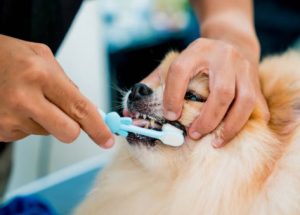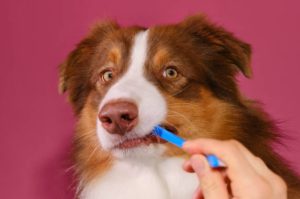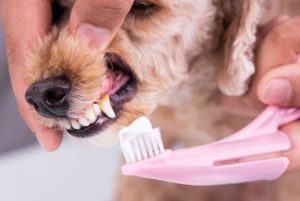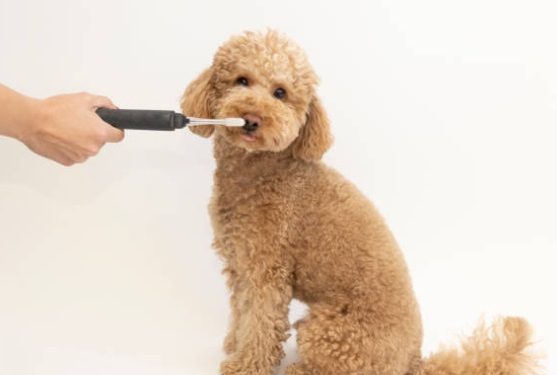How to Brush Your Dog’s Teeth Without Stress.Taking care of our dog’s teeth is just as important as feeding them the right food or taking them for a walk. But, let’s face it—brushing your dog’s teeth can feel like a battle sometimes! The good news is, it doesn’t have to be. With a few simple tips and a calm approach, you can turn teeth brushing into a stress-free (and maybe even enjoyable) routine for both you and your dog.
Why Your Dog’s Dental Health Matters
Before we dive into the how-tos, let’s talk about why brushing your dog’s teeth is so important. Much like humans, dogs can suffer from plaque buildup, gum disease, and even tooth decay. Left untreated, poor dental hygiene can lead to bad breath (no one likes doggy breath!), pain, and more severe health issues like infections. Regular brushing helps keep their teeth healthy, which means fewer vet visits and a happier, healthier pup.

What You’ll Need for Stress-Free Teeth Brushing
To make this experience as smooth as possible, it’s essential to have the right tools. Here’s what you’ll need:
- A Dog-Specific Toothbrush: These come in various shapes and sizes, like finger brushes or long-handled brushes with soft bristles. Choose one that fits your dog’s size and comfort level.
- Dog-Friendly Toothpaste: Never use human toothpaste! Dog toothpaste comes in tasty flavors like chicken or peanut butter, making the process more enjoyable for your pup.
- Treats and Rewards: Positive reinforcement is key, so make sure you have some of your dog’s favorite treats on hand.
Image suggestion: A close-up shot of a dog-specific toothbrush and toothpaste (chicken-flavored, anyone?) next to some treats.
Step 1: Setting the Stage
The first step in brushing your dog’s teeth without stress is picking the right moment. Timing is everything! Don’t try this when your dog is bouncing off the walls with energy or too tired to care. I’ve found that right after a walk or a play session, when my dog is relaxed but not exhausted, is the perfect time.
Find a calm, familiar space where your dog feels safe. Maybe it’s their favorite spot on the couch, or even a cozy corner in your living room. The goal is to keep the environment as chill as possible.
Step 2: Getting Your Dog Used to the Process
One of the biggest mistakes people make is diving straight into brushing. If you suddenly start poking around in your dog’s mouth with a toothbrush, they’re going to be confused or even freaked out. Instead, take it slow.
Start by letting your dog sniff the toothbrush and lick a little toothpaste off of it. This way, they’ll become familiar with the taste and smell. You can even rub a small amount on your finger and gently massage their gums. Think of this as a warm-up for the real thing.
Keep these early sessions short—just a couple of minutes. You’re not aiming to clean every tooth right away; the goal is to help your dog get used to the sensation without feeling anxious.

Step 3: The Power of Positive Reinforcement
Here’s the secret sauce to stress-free teeth brushing: positive reinforcement! Every time your dog allows you to touch their teeth or gums, shower them with praise, treats, or even a quick play session. You want to create a positive association with the toothbrush, so your dog begins to see it as a ticket to yummy rewards.
I usually give my dog a small treat before we start brushing, then another one after. This way, they look forward to the brushing session rather than dreading it.
Pro tip: If your dog is especially nervous, you can even give them a treat for just sitting still while holding the toothbrush. Baby steps!
Step 4: Brushing Techniques
Now that your dog is comfortable with the process, it’s time to get brushing! Start by lifting their lip to expose their teeth. Using gentle circular motions, brush along the gumline, focusing on the outer surfaces of the teeth. Don’t worry too much about the insides—dogs naturally clean this area with their tongue.
Keep the session short and sweet at first. You don’t need to brush every tooth perfectly in one go. Over time, you can increase the duration as your dog gets more comfortable.
If your dog starts showing signs of stress (like lip licking, ears back, or trying to pull away), take a break. It’s important not to push them too far. You can always come back and try again later.
Step 5: Building a Routine
Consistency is key! Aim to brush your dog’s teeth at least a few times a week. Once your dog gets used to the routine, it will become easier and faster. I found that once my dog realized brushing was just part of the day, they stopped resisting and sometimes even looked forward to the post-brushing treat.
Remember: the goal isn’t perfection. Even if you can’t get to every tooth, regular brushing will significantly improve your dog’s dental health.

When to Seek Help
If you’ve tried everything and your dog still resists brushing, don’t stress too much. Some dogs are just more sensitive or anxious about dental care. In this case, it might be a good idea to talk to your vet or a professional groomer for advice. There are also other dental care options, like dental chews or gels, which can help keep your dog’s teeth clean between vet visits.
Conclusion: A Happy, Healthy Smile for Your Dog
Brushing your dog’s teeth doesn’t have to be a stressful event! With patience, positive reinforcement, and a little practice, you can make it a regular part of your dog’s care routine. Not only will you be helping prevent dental disease, but you’ll also strengthen your bond with your pup. So grab that doggy toothbrush, some tasty treats, and start brushing!









Discussion about this post